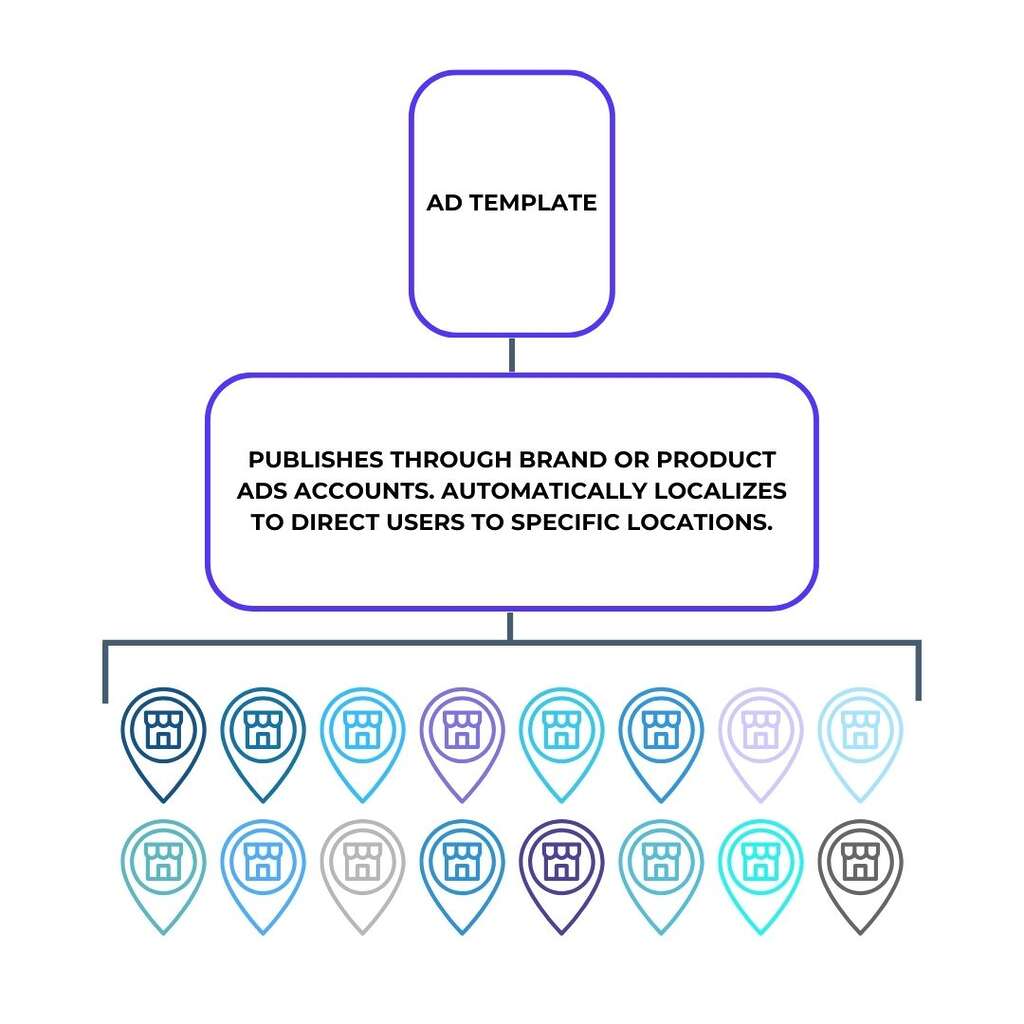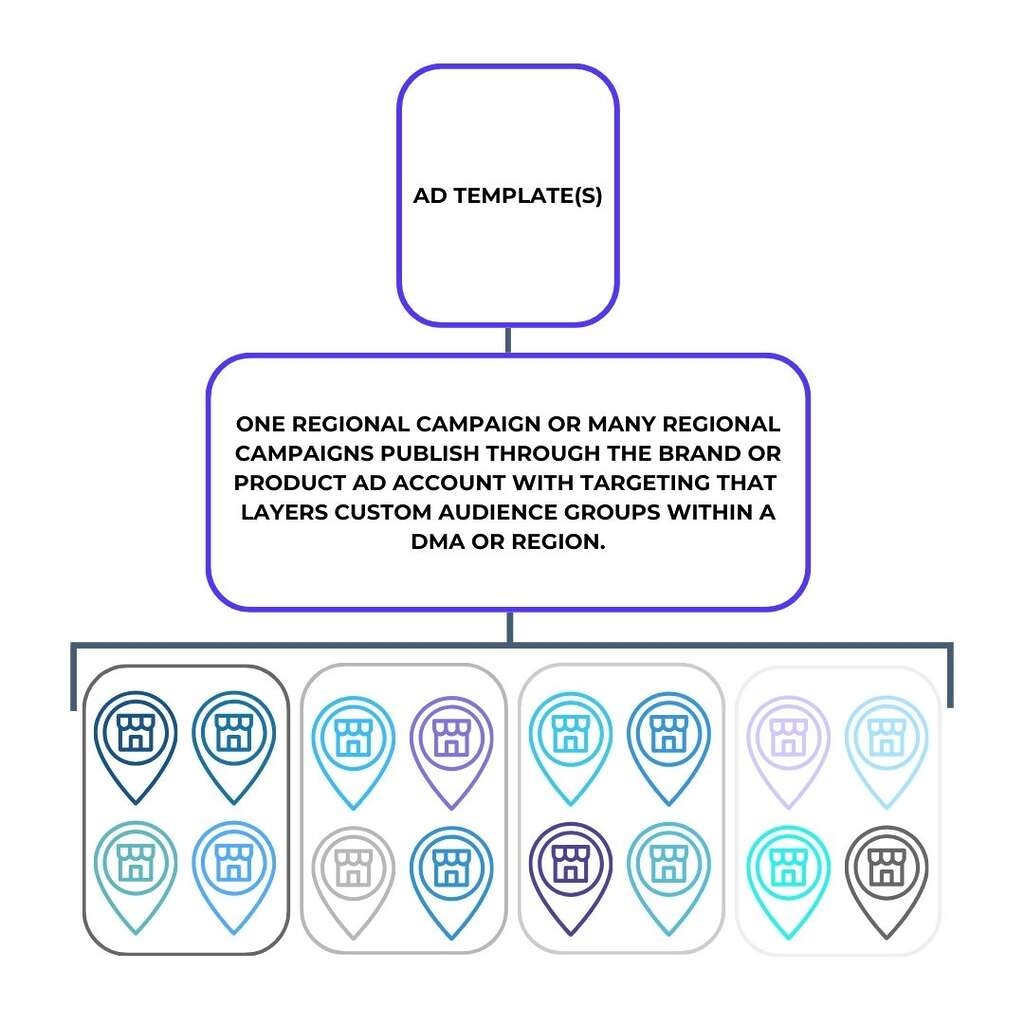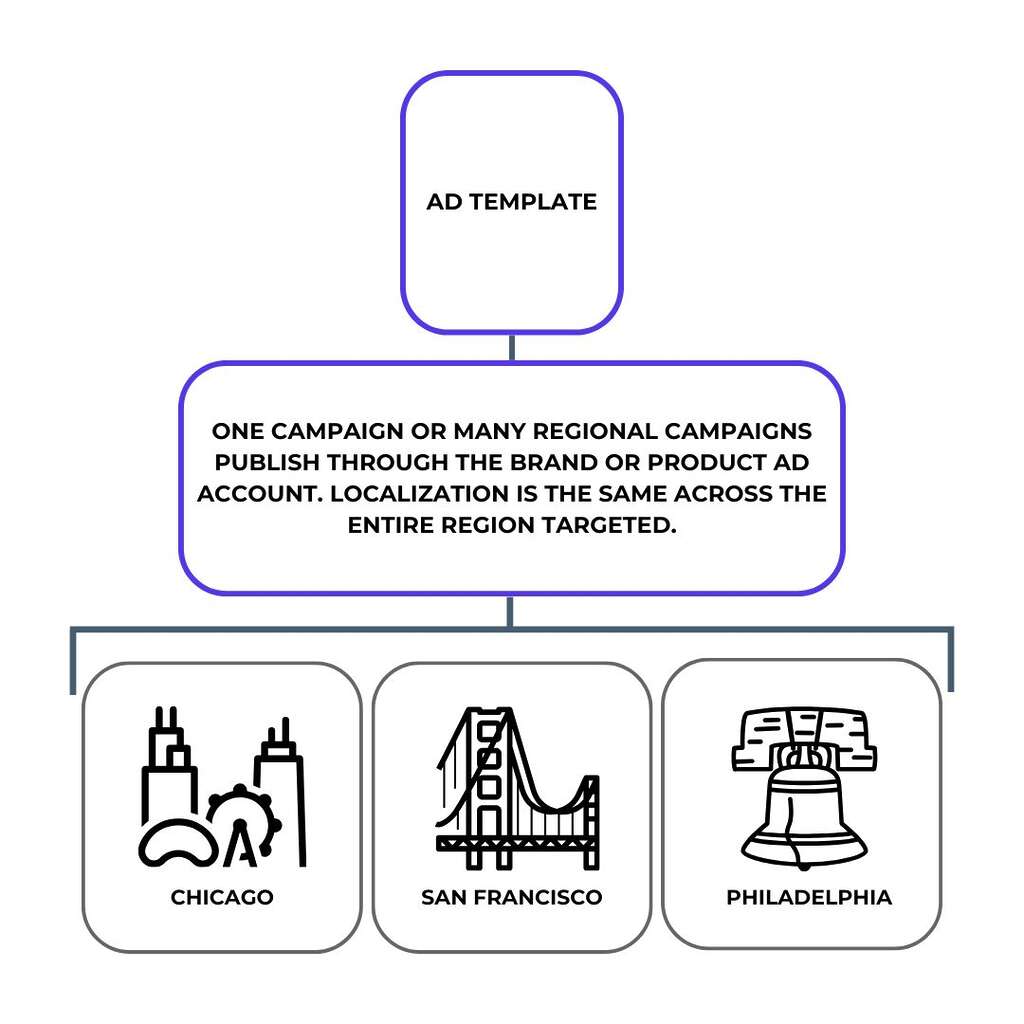Geo-Targeting: A Strategic Approach to Broader Localized Advertising
In addition to retail chain and independent retailer campaigns, geo-targeting provides a flexible method for localizing ads when direct access to individual store accounts isn’t feasible. Geo-targeting maintains brand integrity and complements store-level campaigns by filling coverage gaps across different markets, from busy cities to rural areas.
Three Models of Geo-Targeting Campaigns for Localized Reach
While local ads launched from local digital accounts are the gold standard, these geo-targeting approaches expand reach in targeted areas, maintaining consistent brand messaging, driving traffic to partners, and increasing sales. while. Let’s review the three primary types in descending order of localization customization opportunities.
- Location-Specific Campaigns with Pinpoint Targeting
For brands aiming to direct customers to a specific location, whether a store, vending machine, or kiosk, location-specific campaigns use pinpoint targeting to create highly localized ads that publish from the main brand or product account. By targeting consumers in a defined radius around key locations, this model allows brands to deliver customized messages or calls-to-action (CTAs) that drive traffic to a specific location on a map or a specific location URL. Since each campaign targets a unique area around a location, it provides precise reach even without requiring access to individual store accounts.

Why it works: By creating location-specific campaigns that drive awareness and traffic to that location, ads convert at a higher rate. They are personalized for the location and are more relevant, resulting in lower costs.
Use Case: Desire to create location-specific campaigns, but unable to gain access to location ad accounts.
For example, Coca-Cola has successfully used this approach to increase awareness and vending sales in high-traffic areas.
Coca-Cola sought to stay top-of-mind in highly competitive locations like airports, shopping centers, and universities. Read the case study here.
Using Tiger Pistol’s platform, the beverage giant launched geo-targeted Facebook ads that directed consumers to the nearest vending machines. Locations were established in the platform and location-specific campaigns were published, increasing relevance and driving sales.
2. DMA or Regional Campaigns with Custom Audience Grouping
DMA or regional campaigns group locations within a larger geographical region, targeting consumers across several specific areas combined into a single campaign. This method uses a central account and customized radius targeting (often 1-3 km or miles) to create a unified audience pool around multiple stores. Campaigns can be tailored for regional relevance, such as weather or events, without focusing on one particular location.

Why it works: Broad reach across multiple areas with regional customization, providing an effective solution for brands that need a unified message across locations.
Use Case: Regional brand awareness with customized but non-location-specific content; works well for seasonal promotions or events across multiple nearby locations.
For example, The Wendy’s Company has employed this strategy to maintain brand consistency across different cities while capturing audience attention based on regional preferences. Read the case study here.
3. Broad Regional Campaigns Targeting Entire Cities, States, or Designated Market Areas (DMAs)
For brands prioritizing visibility over specific location engagement, broad regional campaigns allow targeting at a city, state, or regional level. Published from a single brand account, these campaigns build general awareness across large geographical areas, making them well-suited for brands limited by regulatory restrictions or unconventional sales locations.

Why it works: Maximize reach across large areas with minimal setup, enabling brands to drive awareness even in locations where hyper-local campaigns aren’t feasible. This approach provides flexibility, helping brands meet regulatory requirements while still effectively promoting their message across varied, expansive markets.
Use Case: Ideal for brands looking to build widespread visibility across multiple cities, states, or regions, especially when facing limitations like strict advertising regulations, complex distribution networks, or non-traditional sales locations.
For example, BuzzBallz applied this strategy to increase product visibility across various retail stores while adhering to alcohol advertising regulations. Read the case study here.
Integrating Geo-Targeting with Other Localized Advertising Methods
While geo-targeting offers strong reach and flexibility, ads launched directly from retail chain or independent retailer accounts typically outperform geo-targeted campaigns in engagement, return on investment (ROI), and partner satisfaction due to their hyper-local focus. By blending store-level and geo-targeted strategies, brands can cover gaps where retail chain or independent partner access is limited and extend their reach across entire regions or specific high-value areas.
Discover how Tiger Pistol can power your local advertising success.
Related Posts
Leveraging Consumer Beverage Preferences in Competitive Socializing with Local Social Ads
Eatertainment in the USA and competitive socializing in the UK share the same vibrant concept: combining dining and drinking with fun activities like indoor golf, bowling, pickleball, and more. For beverage marketers, these venues present a unique opportunity to blend local advertising with consumer insights, driving on-premise sales. A new report from CGA by N
Converting Cheers to Sales: A Social Advertising Playbook for Beverage Marketers to Boost On-Premise Sales
Harness local social advertising to elevate sports sponsorships, nurture trade relationships, and engage customers Get the Playbook Did You Know? Average Increase in spend on food and drink among fans when watching sports of Fans visit on-premise in larger groups than usual when watching sports of Fans say new business won centered on collaboration with [&helli
Tiger Pistol Unveils Game-Changing Playbook for Beverage Industry Social Advertising Success
Tiger Pistol’ Releases “The Ultimate Local Social Advertising Playbook for Beverage Marketers: A Guide to Empowering Your Trade Partners to Drive On- and Off-Premise Sales” A Must-Have Guide for Beverage Brands Ahead of Peak Sales Season As the peak season for beverage sales approaches, Tiger Pistol, the most advanced collaborative advertising platfor
Tiger Pistol’s New Playbook Unlocks the Power of Vertical Video Advertising
Empowering Marketers with Strategies for Impactful Engagement, “The Ultimate Guide to Vertical Video Advertising” is a Comprehensive Guide to Building Best-Practice Creative, Choosing the Right Social Platforms, and Developing a Winning Social Advertising Strategy. Tiger Pistol, the leading local social media advertising platform, recently announced





